OUR COSTUMES:
The traditional Ibicencan costume stands out because of the simplicity of the mens out fit which contrasts with the more elaborated womens dress, which is extremely original. There are people who still wear the original costumes to dance they have been inherited and go back over two hundred years. One has to recognize the difference between mens and womens clothes which can vary depending on which century it belonged to.
FOR THE WOMEN
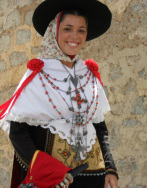
“Black Gonella.” This is the oldest costume from which there are documents dating from the 13th to the 17th century. This includes a tight dress made of wool and linen which covers the area from the chest to the feet, this is decorated with an embroidered apron with geometrical shapes as long as the “gonella” and made out of the same fabric. It has a tailored body and a short gipo with false sleeves which are embroidered on the cuffs and done up with silver buttons or coloured ribbons.
This dress is accompanied by a white embroidered shawl around the shoulders. A type of cap open at the back is worn on the head, allowing the lady’s plait to be seen. This is called a “Cambuix”, then a black felt hat is worn on the top. The chest area is decorated with a type of necklace made from coral and silver. This is a type of Rosary, a jewel and a “Agustinada”(which are necklaces made of coral grains and mother-of-pearl.) Over the time this dress has been altered, going from a white shawl to a yellow shawl, from a “cambuix” to a square white head scarf with no hat. Also a black gonella incrusted with gold instead of coral and silver.
This dress is accompanied by a white embroidered shawl around the shoulders. A type of cap open at the back is worn on the head, allowing the lady’s plait to be seen. This is called a “Cambuix”, then a black felt hat is worn on the top. The chest area is decorated with a type of necklace made from coral and silver. This is a type of Rosary, a jewel and a “Agustinada”(which are necklaces made of coral grains and mother-of-pearl.) Over the time this dress has been altered, going from a white shawl to a yellow shawl, from a “cambuix” to a square white head scarf with no hat. Also a black gonella incrusted with gold instead of coral and silver.
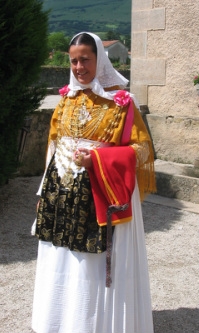
“White Gonella.” Dated the 18th and 19th century, the colours and materials were changed but the pieces are the same as the black gonella. The gonella is now made of white cotton or thread and is pleated. To give the dress more volume, embroidered petticoats are worn. The number of petticoats worn depends on the economical status of the family reaching up to twelve. The sleeves were also made of cotton with wide cuffs decorated with golden buttons and a silk apron sometimes decorated with embroidered small flowers. The shawl which accompanies this costume is usually made of yellow silk or a dark coloured shawl with a border of embroidered flowers.A golden necklace formed of a cross, a jewel, gold ropes and chains and a “adreç” (a small cross) are worn across the chest.
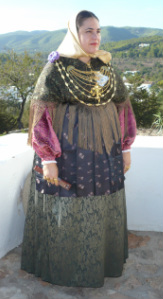
“Coloured Gonella.” This is similar to a white gonella but is made of coloured fabrics, this dates back to the 19th century and continues now a days, where we can still see women wearing this out-fit. It consists of a triangular shawl with fringes, an apron of which there are two types; the short one which can be worn with or without necklaces and the long one that is always worn without jewels and is occasionally accompanied by a white hat made from palm leaves. The head scarves are made from silk, although there are other types like the yellow scarf or the one made from sedalina.
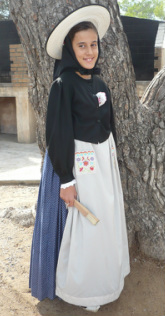
The costume from Formentera is a variation of the coloured gonella which is typical of Formentera. The most significant difference is that instead of wearing a shawl they wear a black short jacket and instead of a coloured scarf on the head they wear a black one with flowers embroidered around the edge.
FOR THE MEN
The mens costumes date back to the same time as the womens and from the oldest to the most recent are the following:
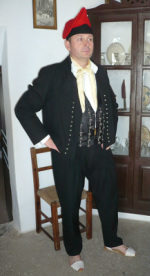
“Vestit de llana negra.” This is the oldest costume formed by black trousers made from wool and linen, wide at the waist and narrower at the ankles, a white linen or cotton shirt, a black waist coat and jacket decorated with silver buttons and a red hat with a black brim.
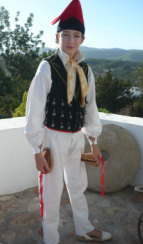
“Vestit de drap.” This is formed by white trousers and shirt with a high collar made from linen or cotton with elaborated embroidery around the cuffs and collar. This out-fit is accompanied by a “toca” which is a large scarf wrapped around the waist over the trousers so as to keep them in place, a neck scarf, a cap and sometimes a silver buttoned waist coat.
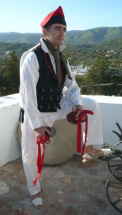
“Justet.”This is a white costume much plainer than the others without embroidery but always with a toca, neck scarf, cap and waist coat with silver buttons.
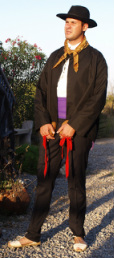
“Vestit de camisola.” This is the name given to describe the most recent suit it is formed by dark bell bottom trousers, a white cotton shirt, a “camisola” which is a wide blouse which fastens at the neck with just one button and made from the same fabric as the trousers and a wide black felt hat.
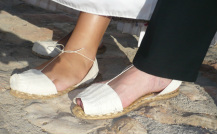
The same for the women as for the men there are two types of shoes known as “espardenyes” and “sabatilles.” The “espardenyes” are made from pita thread which has been whitened with lime and the soles made from plaited esparto grass. The women wear “espardenyes de morret” or “capelleta,” which differ from the mens because the tips are closed. The “sabatilles” are made from canvas and the soles are also made from esparto grass.
